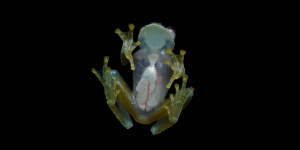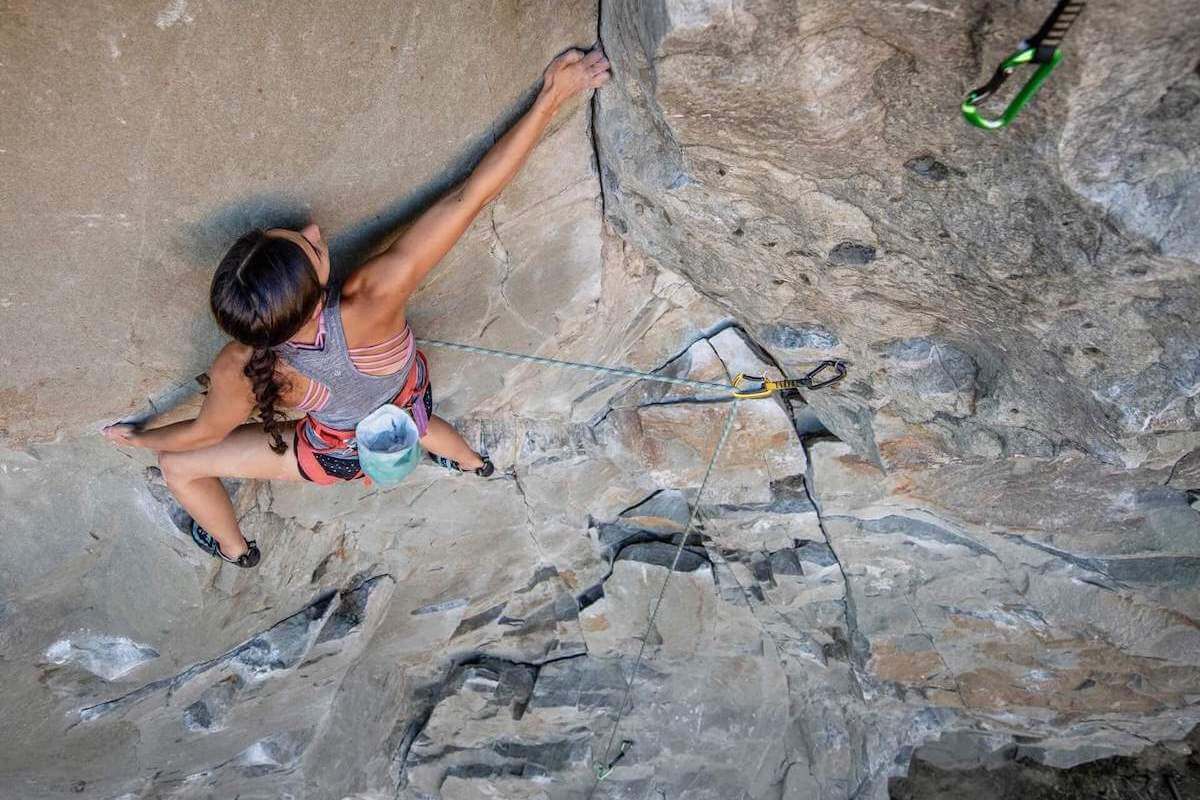
Class of 2022 USC Viterbi biomedical engineering graduate Emily Powis climbing at Tick Rock in Pacific Palisades, California. Image/Jack Green.
As a Coloradan growing up in the shadow of spectacular mountains, mesas and forests, the great outdoors was always going to be a big part of Emily Powis’ life. Being the child of adventurous parents only fueled her daredevil sensibility, with every family trip a camping and hiking trek into the wilderness.
“Our vacations were not really relaxing — they were just us doing something really cool and going to crazy places. It was something that I didn’t realize was abnormal until I spoke to friends about their vacations on the beach,” Powis laughed.
Now, as she graduates from USC Viterbi as a biomedical engineer specializing in 3D ultrasound research, Powis has maintained her sense of adventure. Not only does she lead outdoor expeditions through SC Outfitters, but she’s also co-captain and co-president of the SC climbing team, spending her spare time at California’s climbing hotspots, scaling intimidating rock formations.
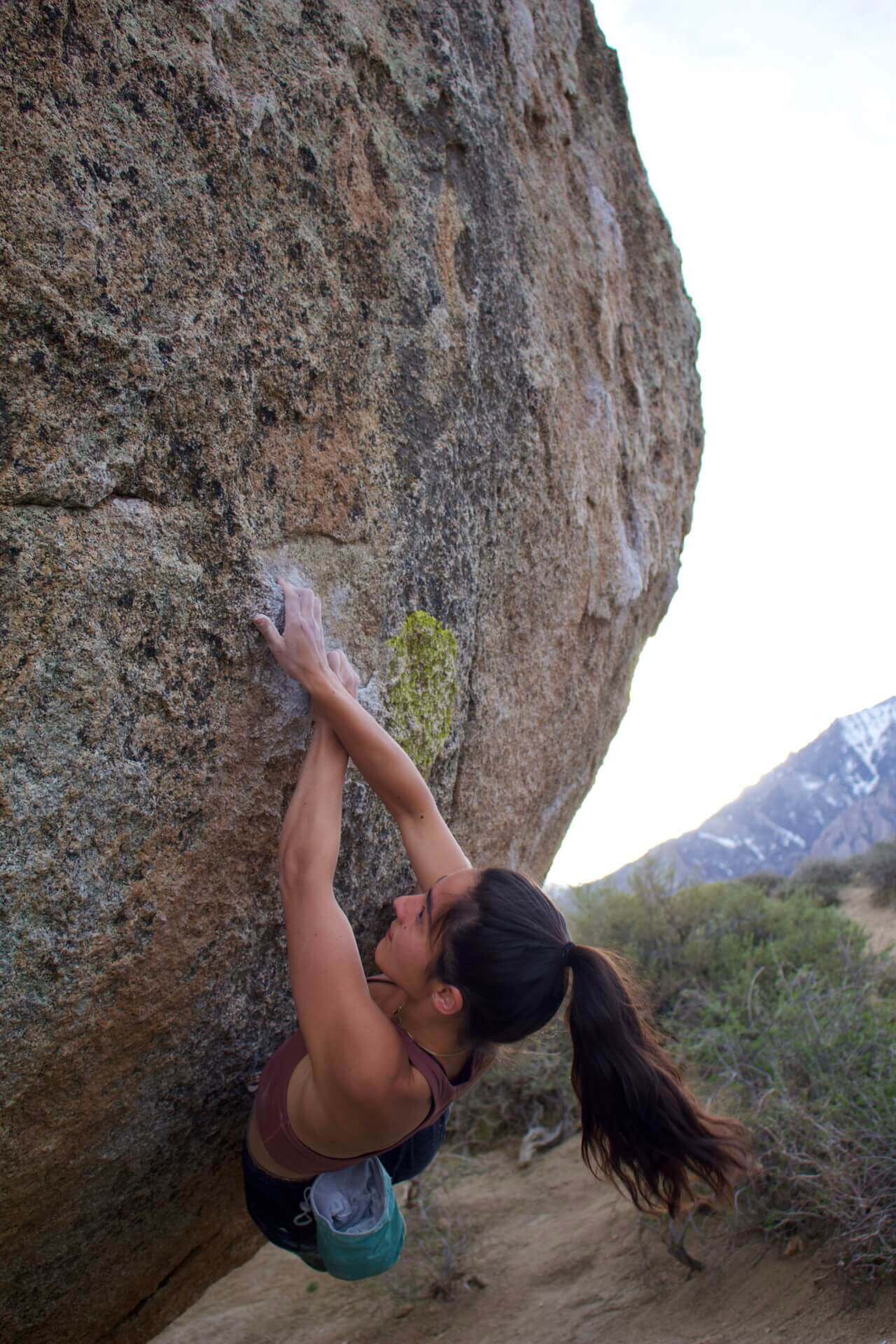
Powis bouldering at Buttermilk Boulders in Bishop, California. Image/Irene Li
It was in high school when Powis was first bitten by the climbing bug. Her parents were lifelong skiers and backpackers, but when they were first dating, Powis said her mom and dad used to go on climbing dates together. So one summer she snuck into the basement and unearthed her parents’ climbing equipment from when they were in college. These ropes, shoes and harnesses would soon become the new tools of her trade.
“I got really into it, and I just ended up going climbing every single day all that summer. I immediately joined the climbing team at my high school, and through that I became much more involved in training and climbing outside,” Powis said.
At school, Powis felt her smaller stature at 5 feet 2 inches made team sports less fun. However, climbing was a natural fit; her physique and flexibility allowed her to mold herself into the impossible shapes needed to reach narrow nooks and holds.
“The great thing about climbing is that every body type and every person has a different style they can use to get up the wall. Even if you are really short, like me — I can do like crazy flexible stuff or scrunch up into a really tight little ball and that’ll help me do the same climb that maybe someone who’s much taller can’t do,” Powis said.
Her initial introduction to the adrenalin rush of climbing was through rope climbing – scaling an overhanging surface all the way to the top with the help of ropes and harnesses. She and her brother would spend their weekends throughout high school at the gym, mastering the art.
“Rope climbing takes a long time but it’s a lot more approachable to a beginner because you can take rests on the way up.”
Ever one for a new challenge, Powis has more recently been enjoying bouldering, free climbs over large boulders, where climbers hang at challenging angles with nothing but their own hands and a crash pad below them. No ropes. No harness.
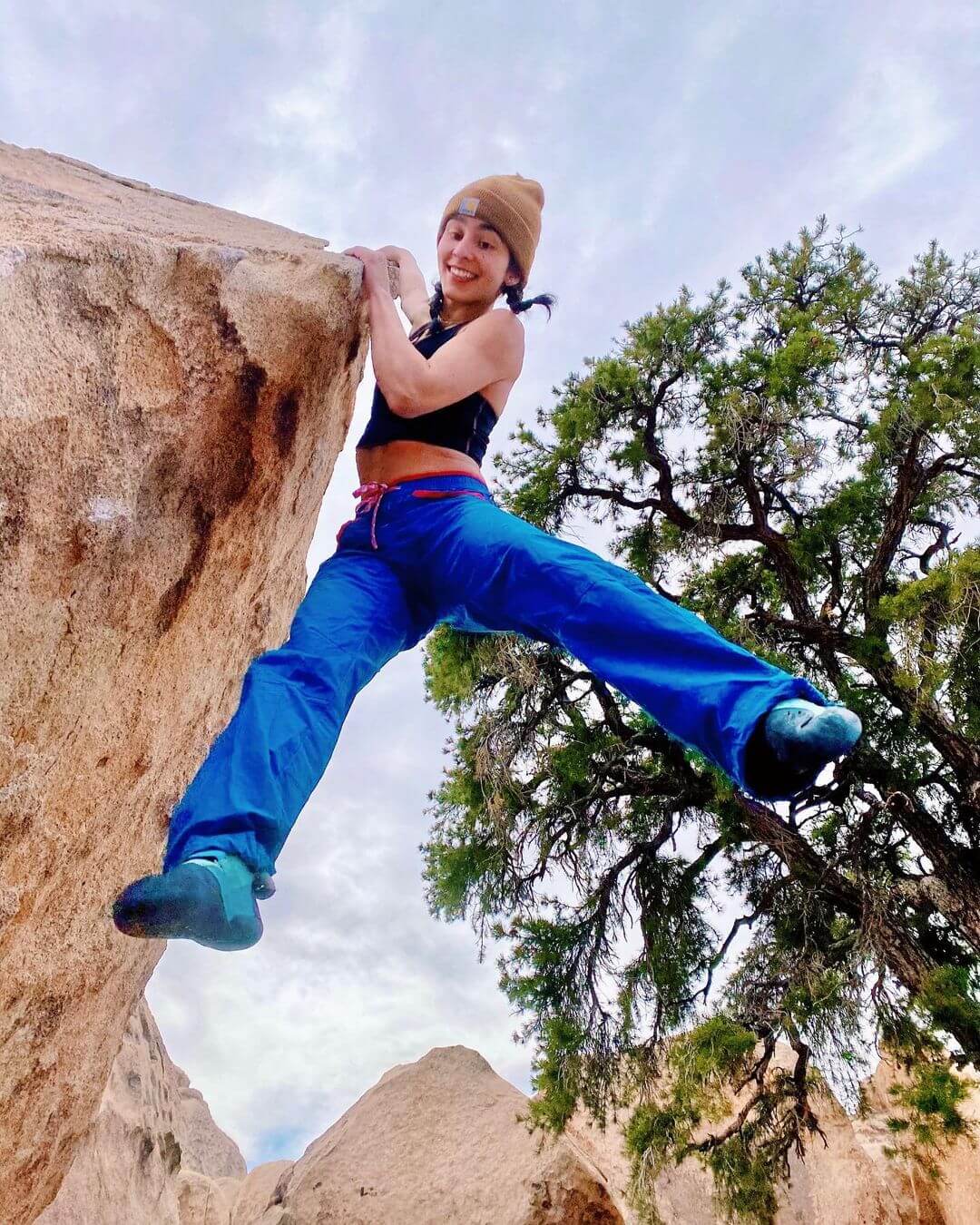
Powis just hanging out at Joshua Tree National Park. Image/Margaret Cirino
“With bouldering you are just climbing over mats and any time you fall, you always will hit the ground. There’s no opportunity to rest. Normally it includes very intense gymnastic moves, which was hard for me as a beginner,” Powis said. “Most people who come into climbing have a baseline level of fitness, but for bouldering you need to get into the mindset you’re going to fall maybe 20 to 30 times, and that’s okay.”
In her free time, you will often find Powis at California’s bouldering mecca, Bishop in the Eastern Sierra region, home to imposing highballs — long, difficult, and potentially dangerous ropeless climbs over large boulders.
“At first, I totally wrote off highball bouldering as something I would never do, but at Bishop I got into it a little bit more. But it’s really scary because you’re up to 30, sometimes 40 or 50 feet up,” Powis said. “For the first 20 feet you have the pad so you’re safe but once you go past that, it’s the ‘no-fall-zone.’ You don’t want to fall, or you could get badly injured.”
Powis said she overcame the fear by strategically picking climbs where the lower part of the climb was difficult, but it became easier on the ascent.
“I’ve realized it’s a lot in my head and I sometimes will get into positions where I’m just climbing upward and I kind of forget about the risk of it.”
Not only is hanging from terrifying rockfaces a passion for Powis, but it’s also one of the reasons she became interested in engineering. As she honed her craft in gyms and on climbing teams, Powis met new friends who, coincidentally, were studying engineering or other STEM disciplines. She started to consider the fact that so many like-minded people also had this in common may be an indication it was a field she should consider. For a climber who is so caught up with problem-solving and strategy in the moment, engineering seemed like a logical choice.
“I’ve talked to a lot of people about it and people think that engineers and STEM-related people enjoy climbing because it’s a high failure sport. You have to be used to falling a bunch,” Powis said. “I think that’s very similar to engineering and research because you’re constantly making very incremental progress towards your goal, and I think it takes a special person to want to do that.”
Powis has been conducting 3D ultrasound research in the lab of Associate Professor of Biomedical Engineering Jesse Yen, where her focus has been on the electrical aspects of the technology, such as the printed circuit board design and connectors.
“You don’t really hear about 3D ultrasound much because most of the ultrasounds you see in the doctor’s office or on TV are just the planar view, and that’s because 3D ultrasound is really expensive, so Dr. Yen and the rest of our team is working on creating low-cost 3D ultrasound devices,” Powis said.
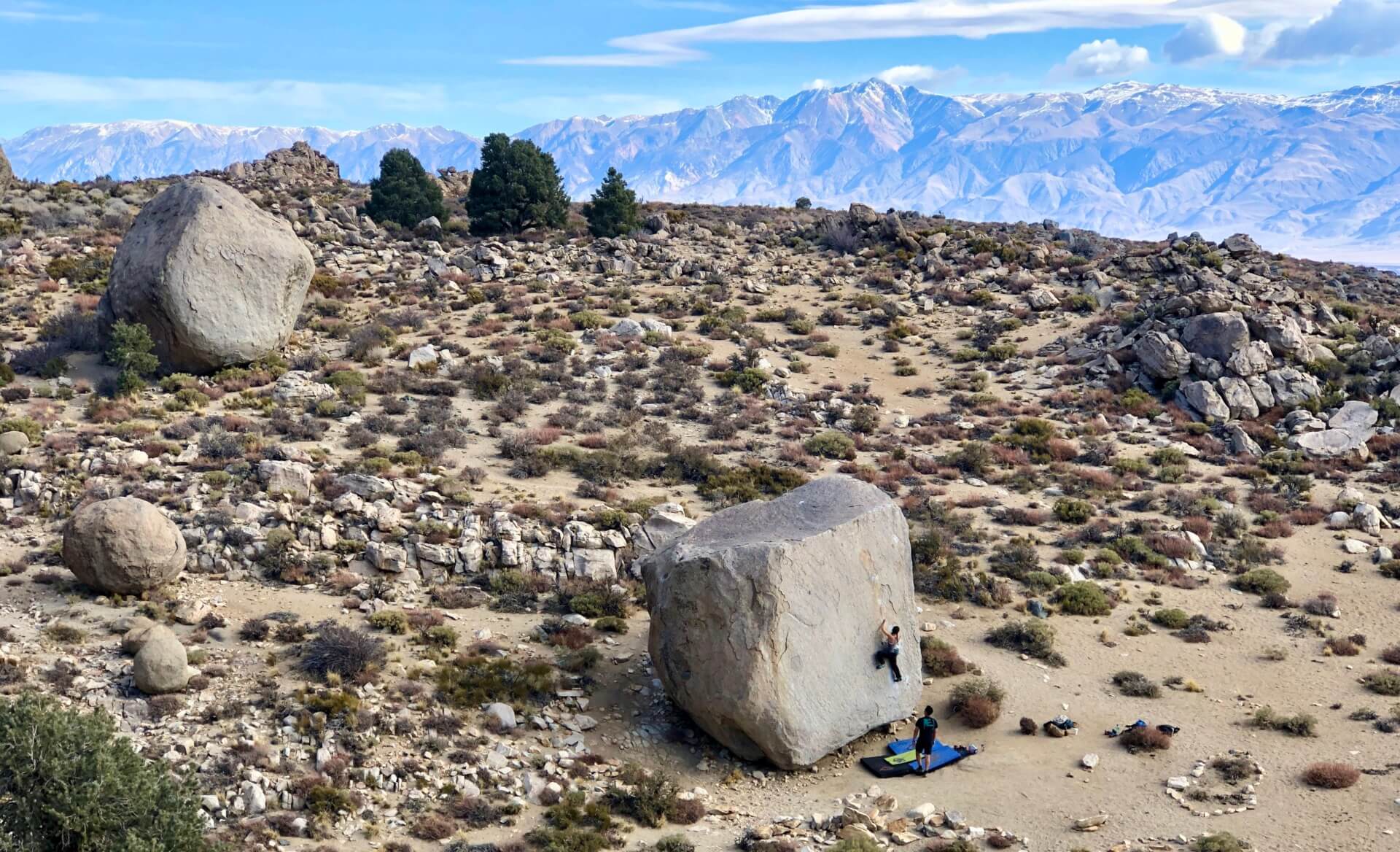
Powis embarks on one of her first highball experiences at Bishop, California on the “Jedi Mind Tricks” climb in the Pollen Grains. Image/Matthew Pozzi
Powis has also been keeping busy working as an EMT, giving her a solid grounding for her future plan to study medicine. In the next year she hopes to move to her beloved Bishop to work on her medical school applications while continuing her climbing adventures.
Powis says she can see some exciting crossovers between her future medical career and climbing.
“I can definitely see potential with my outdoor interests. I recently found out there’s a residency in wilderness medicine that you can do and then hopefully you can work in areas like search and rescue, which I think would be very cool and is something I’m really interested in,” Powis said.
For Powis, the understanding that climbing has given her about the human body and the unique physical toll the sport can have is also something she’s interested in exploring through medicine. Many of her friends have persistent injuries such as damaged tendons in their fingers, which can prohibit them from climbing for many months.
“Because climbing injuries are very niche, there are a lot of famous climber doctors who offer advice about how to prevent them. I think it would be cool to look more into the physiology of how these injuries happen.”
Read more about Powis’ outdoor adventures at Viterbi Voices.
Published on May 11th, 2022
Last updated on May 19th, 2023




